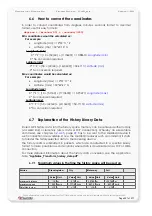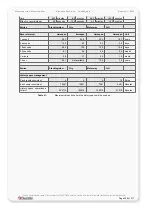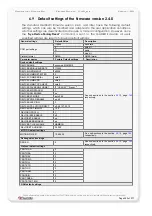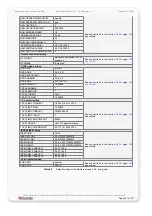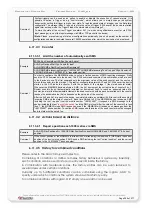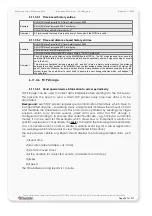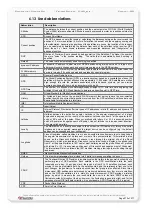
C
ONFIGURATION
C
OMMAND
S
ET
- F
IRMWARE
R
EVISION
2.4.0_
BETA
-
V
ERSION
1.0.0
6.13 Used abbreviations
Abbreviation
Description
Altitude
The distance between the current position and the nearest point on WGS-84 (World Geodetic
System 1984) reference ellipsoid. Altitude is usually expressed in meter an is positive outside the
ellipsoid.
APN
Access Point Name
Current position
The GPS is based on satellite ranging - calculating the distances between the receiver and the
position of 3 or more satellites (4 or more if elevation is desired) and then applying some good
old mathematics. Assuming the positions of the satellites are known, the location of the receiver
can be calculated by determining the distance from each of the satellites to the receiver. GPS
takes these 3 or more known references and measured distances and "triangulates" an
additional position.
DOP
Dilution of Precision. Errors caused by bad geometry of the Satellites. The higher the number,
the more "noise" in the position reading.
.
The value that is automatically used if nothing is
specified.
Default
The value that is automatically used if nothing is specified.
dynamic IP address
A dynamic IP address is what most of GPRS devices using dial up services. This type of IP
address will usually change each and every time you log on to the GPRS services.
FLASH memory
A particular type of memory that is permanent and the data written on it will be not lost when the
device is turned off. It can be updated and upgraded by special program.
GPRS
General Packet Radio Service
GPS
The Global Positioning System (GPS) is a location system based on a constellation of about 24
satellites orbiting the earth at altitudes of approximately 11,000 miles. GPS satellites are orbited
high enough to avoid the problems associated with land based systems, yet can provide
accurate positioning 24 hours a day, anywhere in the world.
GPS Time
The number of seconds since Saturday/Sunday Midnight UTC, with time zero beginning this
midnight. Used with GPS Week Number to determine a specific point in GPS Time.
GSM
Global Standard for Mobile Communications
History
A limited part (section) on the on-board FLASH memory that serves to save the user-selected
position records (the current data position received from the GPS satellites) and those data can
be available for evaluation in a later time.
IMEI
International Mobile Equipment Identity
I/O
Input/Output
IP
Internet Protocol. Providers offer two types of IP addresses –static IP address and dynamic IP
address.
Latitude
Halfway between the poles lies equator. Latitude is the angular measurement of a place
expressed in degrees north or south of the equator. Latitude runs from 0º at the equator to 90º
north or 90º south at the poles. When not prefixed with letters E or W, it is assumed positive
north of Equator and negative south of Equator. Lines of latitude run in an east-west direction.
They are called parallels.
Locally
The MAMBOII unit is directly connected to the host device (PC/Laptop etc.) through the serial
interface and via supported messages the target device can be configured (e.g. the default
settings can be changed and new configured).
Longitude
Lines of longitude, called meridians, run in a north-south direction from pole to pole. Longitude is
the angular measurement of a place east or west of the prime meridian. This meridian is also
known as the Greenwich Meridian, because it runs through the original site of the Royal
Observatory, which was located at Greenwich, just outside London, England. Longitude runs
from 0º at the prime Meridian to 180º east or west, halfway around the globe. When not prefixed
with letters E or W, it is assumed positive east of Greenwich and negative west of Greenwich.
The International Date Line follows the 180º meridian, making a few jogs to avoid cutting through
land areas.
NMEA
National Marine Electronics Association
Outbox
It is a temporary
storage
place, divided into 5 parts, for messages waiting to be sent.
PDOP
The Positional Dilution Of Precision is a numeric value that refers to the geometric suitability of a
particular group of GPS satellites. Each satellite in the GPS constellation orbits the earth
repeatedly every day. At any given time, there can be from 5 to 12 satellites overhead, each
moving in its own predictable path. As the satellites orbit, and the relationship from one to the
next changes, the geometry of a solution derived from that group is also affected. Since three-
dimensional GPS positions are determined by measured distances from four or more satellites,
and as the GPS constellation is in a state of constant movement, PDOP provides a relative
gauge by which to measure the end result while the user is in the field. PDOP values will
fluctuate constantly throughout the day; however, the fluctuation is generally slight, and for the
purposes of most GIS field data collection, it is unnoticeable. A PDOP reading of 2-5 is typical.
PDP
Packet Data Protocol
PPP
Point to Point Protocol
This confidential document is a property of FALCOM and may not be copied or circulated without previous permission.
Page 270 of 271


